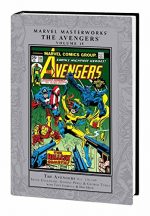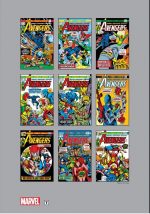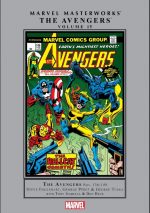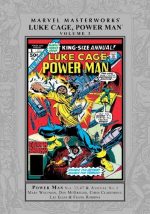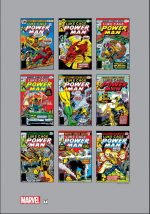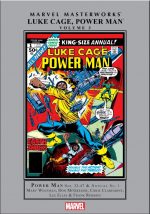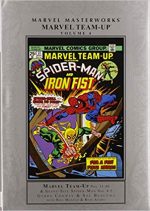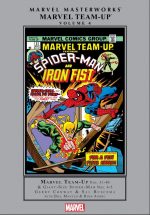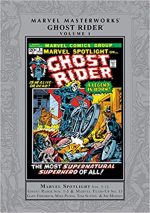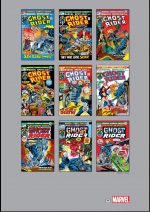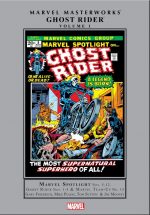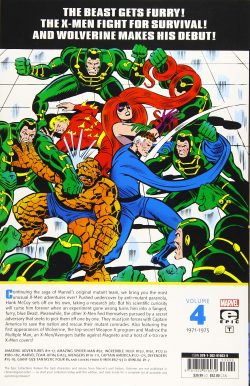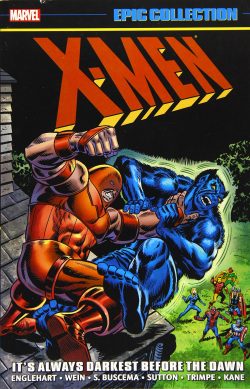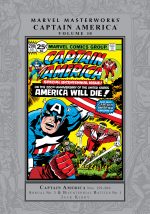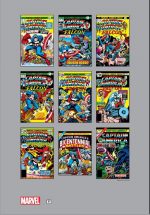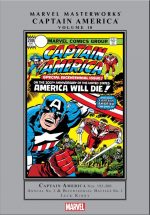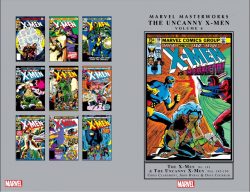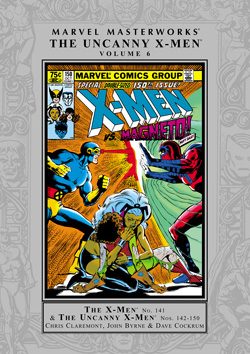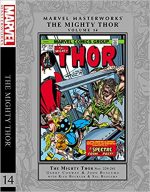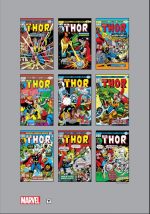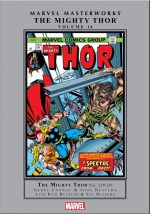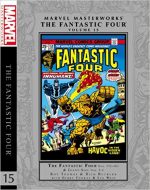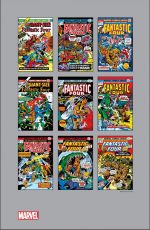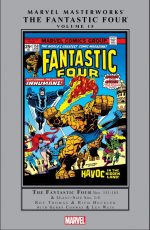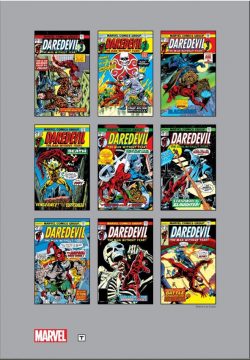
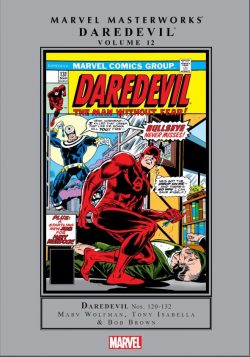
By Tony Isabella, Marv Wolfman, Len Wein, Bob Brown, Gene Colan, Klaus Janson & various (Marvel)
ISBN: 978-1-3029-0968-0 (HB)
Matt Murdock is a blind lawyer whose remaining senses hyper-compensate, making him an astonishing acrobat, formidable fighter and living lie-detector. Very much a second-string hero for much of his early years, Daredevil was nonetheless a striking and popular one, due in very large part to the captivatingly humanistic art of Gene Colan. He fought gangsters, a variety of super-villains and even the occasional monster or alien invasion, quipping and wisecracking his way through life and life-threatening combat, utterly unlike the grim, moody, quasi-religious metaphor he became in later years.
After a disastrous on-again, off-again relationship with his secretary Karen Page, Murdock took up with Russian émigré Natasha Romanoff, the infamous and notorious spy dubbed Black Widow. She was railroaded and framed for murder and prosecuted by Matt’s best friend and law partner Foggy Nelson before the blind lawman cleared her. Leaving New York with her for the wild wacky and West Coast, Matt joined a prestigious San Francisco law firm but adventure, disaster and intrigue sought out the Sightless Swashbuckler and ultimately drew him back to the festering Big Apple…
This 12th hardback and eBook collection re-presents Daredevil #120-132, spanning April 1975 through April 1976, and opens with a brace of Introductions from successive scripters Tony Isabella – ‘Man Without Fear Meets Writer with a Plan and How the Latter Went Somewhat Awry’ – and Marv Wolfman who reminisces over ‘Searching for a Hero’…
Crafted by Isabella, Bob Brown & Vince Colletta, Daredevil #120 began an extended story-arc focussing on the re-emergence of the world’s most powerful secret society. ‘…And a Hydra New Year!’ sees Black Widow hit New York for one last attempt to make the rocky relationship work, only to find herself – with Matt and Foggy – knee-deep in Hydra soldiers at a Christmas party.
The resurgent terrorist tribe has learned America’s greatest security agency needs to recruit a legal expert as one of their Board of Directors and – determined to prevent the accession of ‘Foggy Nelson, Agent of S.H.I.E.L.D’ at all costs – have dispatched the formidable wild man El Jaguar and an army of masked thugs to stop him before he can start. Thankfully, Nick Fury and his crack commandos arrive in time to drive off the attackers but the rumour is true and Foggy is now a marked man…
The new organisation has scoured the ranks of the criminal classes – and Marvel’s back catalogue – for its return and the B-Lister likes of Dreadnought, Commander Kraken, Man-Killer, Mentallo, The Fixer, Blackwing and many other not-so golden oldies happily toil for the enigmatic new Supreme Hydra as he continually strives to take out the increasingly harried Foggy. Eventually, they succeed in capturing the portly District Attorney and the Widow goes off the deep end in #122’s ‘Hydra-and-Seek’, turning New York into a war-zone as she hunts for clues, culminating in a brutal showdown and ‘Holocaust in the Halls of Hydra!’
The times, mood and scripter were changing however, and the next two issues comprise a turn to darker, more gothic dramas beginning with #124 and the advent of a vigilante killer patterned on an old pulp fiction hero.
Written by Len Wein & Marv Wolfman and illustrated by veteran penciller Gene Colan (with Klaus Janson inking) ‘In the Coils of the Copperhead!’ courts the controversial gritty realism then remaking Batman over at DC Comics as the Widow finally really and truly walks out on DD, leaving the frustrated hero to bury himself in the mystery of a murdering madman savagely overreacting to petty crime and leaving a trail of bodies behind him…
Foggy meanwhile is up for re-election and losing on all counts to the too-good-to-be true Blake Tower. Sadly, Matt can’t offer any help or support as he tracks down the secret of the vigilante. The resultant clash doesn’t go the Scarlet Swashbuckler’s way either, and he starts issue #125 with the terrifying realisation that ‘Vengeance is the Copperhead!’ (by Wolfman, Brown & Janson) before achieving a last-minute, skin-of-the-teeth hollow victory…
Fully in command as writer and editor, Wolfman began a long-term revision of the character as ‘Flight of the Torpedo’ (art by Brown & Janson) introduces insurance agent and gone-to-seed football hero Brock Jones who – in classic Hitchcockian manner – stumbles into a plot to control the world and inherits a rocket-powered super-suit coveted by deadly enemy agents. Unfortunately, DD has just been almost killed by the rocket suit’s previous owner and, blithely unaware, seeks to renew the brutal grudge fight…
The battle escalates in #127 as ‘You Killed that man Torpedo… and Now You’re Going to Pay!’ sees the inevitable misunderstanding escalate with both weary warriors losing all perspective and almost killing a family of innocent bystanders until shamed into a ceasefire..
Guilt-ridden and remorseful, Murdock swears off swashbuckling in #128 until uncanny events dictate and demand the return of the Man Without Fear. ‘Death Stalks the Stairway to the Stars!’ introduces a mysterious figure literally walking into intergalactic space and features the return of teleporting psychopath Death-Stalker in pursuit of ancient objects of power, but the real inducements to intrigue are Matt’s pushy, flighty girlfriend Heather Glenn and the increasing efficacy of attack ads targeting Foggy. Not only do they slanderously belittle the incumbent DA, but – 40 years before our own problems with “Fake News†– increasingly challenge consensus reality with patently absurd and scurrilous statements about all authority figures…
The media maelstrom intensifies in ‘Man-Bull in a China Town!’ as “leaked†films “prove†that both John F. and Robert Kennedy are still alive even as Murdock scours the city for his latest client. Rampaging monster Man-Bull escaped court during his lawyer’s summing up and stalks the city, aided and abetted by one of DD’s oldest enemies, but ultimately cannot escape his dreadful fate…
Urban voodoo and a slickly murderous conman infest #130 as ‘Look Out, DD… Here Comes the Death-Man!’ finds the prestigious blind lawyer opening a storefront legal services operation for the disadvantaged even as the misinformation campaign peaks. Meanwhile brutal Brother Zed demands a human sacrifice and a terrified mother finds her only hope is a devil in red…
Closing this spectacular compilation is the 2-part debut of a villain who would become one of the most popular psycho-killers in the business. ‘Watch Out for Bullseye… He Never Misses!’ sees wealthy men very publicly targeted for extortion by a mystery murderer who can turn any object – from paper plane to garbage can – into a deadly weapon. Hunted by the Man without Fear, the lethal loon turns the table on DD in ‘Bullseye Rules Supreme!’, until a final fateful battle settles the case and begins a lifelong obsession for both men…
Supplementing the circumstances above described, the book also offers contemporaneous features from Marvel’s F.O.O.M. magazine #13 (March 1976) spotlighting the Scarlet Swashbuckler. Following a stunning cover by Colan, numerous articles explore the character – such as ‘Through the eyes of a Beholder’ (by Naomi Basner & Chris Claremont, featuring Colan pencil art and gorgeous model sheets crafted by Wally Wood when he took over the strip) and Basner’s ‘The Women in Daredevil’s Life’.
‘Buscema’s Bullpen’ offers art from the illustrator’s then students – and yes, some of them went on to far greater things! – after which Claremont interviews Stan Lee & Wolfman in ‘A Talk with the Men behind the Man Without Fear’ before a Daredevil Checklist segues into Gil Kane’s cover sketch for Giant-Size Daredevil #1 and a repro of the published image.
Both issues #120 and 121 were supplemented by text pages outlining the convoluted history of Hydra and they’re reprinted here too to keep us all in the arcane espionage loop, before a selection of original art pages by Brown & Colletta, Colan & Janson and Brown and Janson remind just how good this hero can look…
As the social upheaval of the 1970s receded, these fabulous fantasy tales strongly indicated the true potential of Daredevil was in reach. Their narrative energy and exuberant excitement are dashing delights no action fan will care to miss.
…And the next volume heads into darker shadows and the grimmest of territory…
© 1975, 1976, 2018 Marvel Characters, Inc. All rights reserved.

